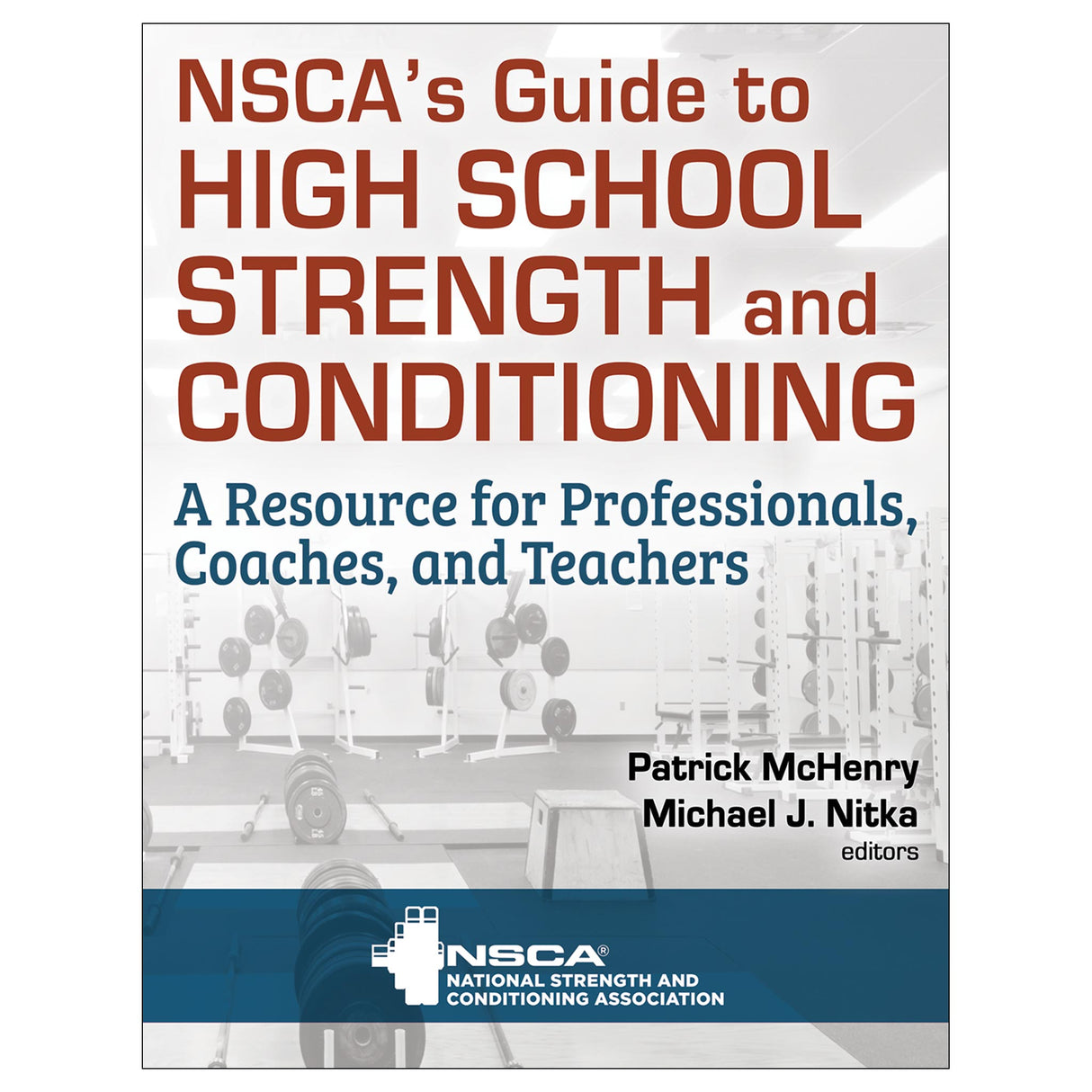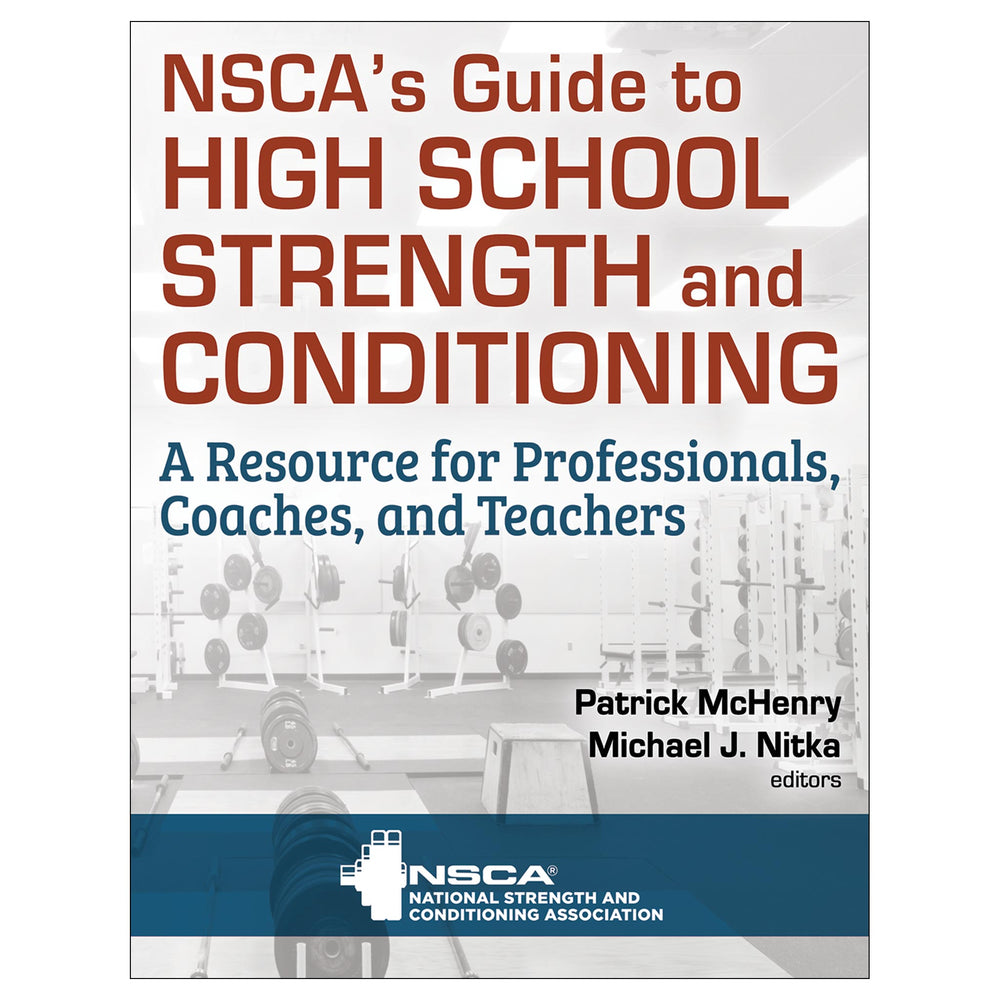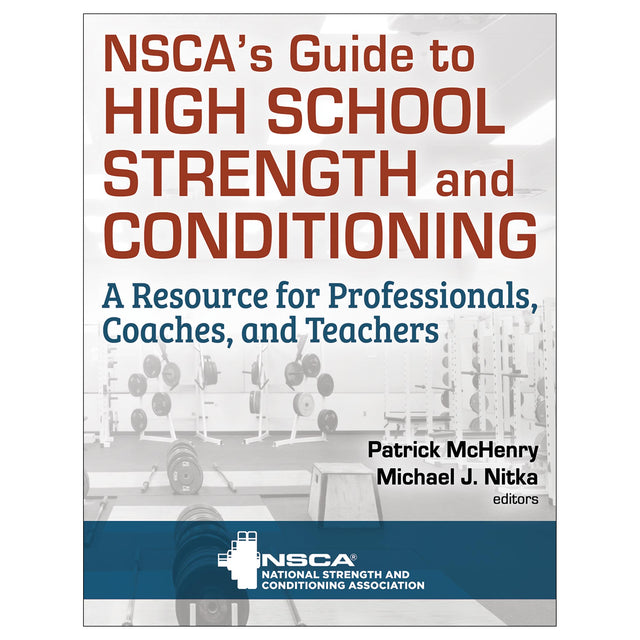Paperback
NSCA’s Guide to High School Strength and Conditioning
Author: Patrick McHenry, Mike Nitka
$75.95 CAD
Unit price
/
Unavailable
Paperback
$75.95 CAD
$75.95 CAD
Paperback
The need for qualified high school strength and conditioning professionals has never been greater. Whether following the framework for long-term athletic development or teaching weight training as a lifelong fitness activity, you need to offer both the environment and instructional skills to safely develop strong student-athletes. NSCA’s Guide to High School Strength and Conditioning will equip you to deliver the highest-quality program in the high school setting—whether you are a strength and conditioning professional, physical education teacher, sport coach, or administrator.
Written by a team of contributors within the world-renowned National Strength and Conditioning Association, NSCA’s Guide to High School Strength and Conditioning summarizes the primary duties and responsibilities of the various positions and roles that contribute to developing a safe and effective program. It provides insights into the benefits of offering a strength and conditioning program at the high school level and offers advice for the implementation of such a program. Examples are also provided for strength-and-conditioning-related PE curriculums to demonstrate how those types of programs can work and how they connect to the SHAPE America national standards and grade-level outcomes.
The text is loaded with information that can be practically applied to any high school program. You will learn the variables to consider when designing a resistance or cardiovascular training program and 13 detailed protocols for conducting assessments so you can objectively evaluate movement and performance. Detailed exercise descriptions include beginning position, movement phases, breathing guidelines, modifications and variations, and coaching tips. The descriptions, along with accompanying photos, teach proper technique for
NSCA’s Guide to High School Strength and Conditioning includes the evidence-driven information that will help any high school strength and conditioning professional—including both coaches and teachers—to become the best practitioner possible. This valuable resource is one that you will turn to for many years to come as you build a solid strength and conditioning community for your student-athletes.
Earn continuing education credits/units! A continuing education course and exam that uses this book is also available. It may be purchased separately, or as part of a package that includes all the course materials and exam.
Written by a team of contributors within the world-renowned National Strength and Conditioning Association, NSCA’s Guide to High School Strength and Conditioning summarizes the primary duties and responsibilities of the various positions and roles that contribute to developing a safe and effective program. It provides insights into the benefits of offering a strength and conditioning program at the high school level and offers advice for the implementation of such a program. Examples are also provided for strength-and-conditioning-related PE curriculums to demonstrate how those types of programs can work and how they connect to the SHAPE America national standards and grade-level outcomes.
The text is loaded with information that can be practically applied to any high school program. You will learn the variables to consider when designing a resistance or cardiovascular training program and 13 detailed protocols for conducting assessments so you can objectively evaluate movement and performance. Detailed exercise descriptions include beginning position, movement phases, breathing guidelines, modifications and variations, and coaching tips. The descriptions, along with accompanying photos, teach proper technique for
- 28 common resistance training exercises,
- 10 bodyweight exercises,
- 12 anatomical core exercises,
- 11 static and dynamic stretching exercises,
- 12 plyometric exercises,
- 10 speed and agility drills, and
- 5 cardio machines.
NSCA’s Guide to High School Strength and Conditioning includes the evidence-driven information that will help any high school strength and conditioning professional—including both coaches and teachers—to become the best practitioner possible. This valuable resource is one that you will turn to for many years to come as you build a solid strength and conditioning community for your student-athletes.
Earn continuing education credits/units! A continuing education course and exam that uses this book is also available. It may be purchased separately, or as part of a package that includes all the course materials and exam.
Audience
Strength and conditioning professionals, sport coaches, and physical education teachers who work with high school student-athletes. Preface
Rick Howard, Patrick McHenry, and Mike Nitka
Introduction. Strength and Conditioning-Related Professionals in the High School Setting
Edwin C. Jones and Shawn L. Jenkins
Chapter 1. Curriculum and Class Structure and Guidelines
Anthony S. Smith and Bruce R. Harbach
Chapter 2. Class Scheduling, Planning, and Assessments
Gary S. McChalicher and Brandon Peifer
Chapter 3. Strength and Conditioning-Related Resources for Teachers and Professionals
Patrick Mediate and Mike Nitka
Chapter 4. Resistance Training Exercises
Scott Sahli
Chapter 5. Bodyweight Exercises
Jim Davis
Chapter 6. Core Exercises
Joe Lopez
Chapter 7. Warm-Up
Darnell K. Clark
Chapter 8. Resistance Training
Shana McKeever and Rick Howard
Chapter 9. Plyometric Training
Samuel Melendrez
Chapter 10. Speed and Agility Training
Phil Tran and Ray Karvis
Chapter 11. Individual and Group Activities
Daniel Flahie
Appendix. NSCA Strength and Conditioning Professional Standards and Guidelines
Rick Howard, Patrick McHenry, and Mike Nitka
Introduction. Strength and Conditioning-Related Professionals in the High School Setting
Edwin C. Jones and Shawn L. Jenkins
Chapter 1. Curriculum and Class Structure and Guidelines
Anthony S. Smith and Bruce R. Harbach
Chapter 2. Class Scheduling, Planning, and Assessments
Gary S. McChalicher and Brandon Peifer
Chapter 3. Strength and Conditioning-Related Resources for Teachers and Professionals
Patrick Mediate and Mike Nitka
Chapter 4. Resistance Training Exercises
Scott Sahli
Chapter 5. Bodyweight Exercises
Jim Davis
Chapter 6. Core Exercises
Joe Lopez
Chapter 7. Warm-Up
Darnell K. Clark
Chapter 8. Resistance Training
Shana McKeever and Rick Howard
Chapter 9. Plyometric Training
Samuel Melendrez
Chapter 10. Speed and Agility Training
Phil Tran and Ray Karvis
Chapter 11. Individual and Group Activities
Daniel Flahie
Appendix. NSCA Strength and Conditioning Professional Standards and Guidelines
Patrick McHenry, MA, CSCS,*D, RSCC, earned a master’s degree in physical education from University of Northern Colorado and a bachelors in elementary education. He has been a frequent presenter at local, state, national, and international conferences, including the national conference of the National Strength and Conditioning Association (NSCA).
McHenry was the American Football Monthly Regional Strength Coach of the Year in 2004, NSCA’s High School Coach of the Year in 2005, and recipient of the Strength and Conditioning Journal Editorial Excellence Award in 2006. He also received the Strength of America Award from the President’s Council on Fitness, Sports and Nutrition and was named Colorado High School Physical Education Teacher of the Year in 2012.
Mike Nitka, MS, CSCS,*D, RSCC*E, FNSCA*E, played football and earned a bachelor of science degree and master of science degree in health and physical education from the University of Wisconsin at La Crosse. He taught freshman physical education and junior health education at Muskego High School in Wisconsin for 38 years and coached football and wrestling, winning every level of championship Wisconsin offered (conference, regional, sectional, and state).
Nitka became an NSCA member in 1985 and, over time, earned the credentials of CSCS,*D, RSCC*E, and FNSCA*E. He presented at the 1992 NSCA national conference and discussed the concept of weight training as a unit within a high school’s physical education curriculum. He served as chair of what would eventually become the NSCA’s High School Special Interest Group and as a member of the NSCA Conference Committee. He was the “Coaches Corner” column editor for the NSCA’s Strength and Conditioning Journal, with the vision to reach out to high school coaches across the country to ask them to share what they were doing in their PE classes.
Nitka was selected as the NSCA’s High School Strength and Conditioning Professional of the Year in 1994 and represented the NSCA in China and Australia as a member of the NSCA’s board of directors. He contributed expertise and feedback for NSCA’s informational brochure for high schools (“What’s Missing? Why You Need a Qualified Strength and Conditioning Coach in Your School”) and currently serves as an adjunct professor of exercise science at Carroll University.
McHenry was the American Football Monthly Regional Strength Coach of the Year in 2004, NSCA’s High School Coach of the Year in 2005, and recipient of the Strength and Conditioning Journal Editorial Excellence Award in 2006. He also received the Strength of America Award from the President’s Council on Fitness, Sports and Nutrition and was named Colorado High School Physical Education Teacher of the Year in 2012.
Mike Nitka, MS, CSCS,*D, RSCC*E, FNSCA*E, played football and earned a bachelor of science degree and master of science degree in health and physical education from the University of Wisconsin at La Crosse. He taught freshman physical education and junior health education at Muskego High School in Wisconsin for 38 years and coached football and wrestling, winning every level of championship Wisconsin offered (conference, regional, sectional, and state).
Nitka became an NSCA member in 1985 and, over time, earned the credentials of CSCS,*D, RSCC*E, and FNSCA*E. He presented at the 1992 NSCA national conference and discussed the concept of weight training as a unit within a high school’s physical education curriculum. He served as chair of what would eventually become the NSCA’s High School Special Interest Group and as a member of the NSCA Conference Committee. He was the “Coaches Corner” column editor for the NSCA’s Strength and Conditioning Journal, with the vision to reach out to high school coaches across the country to ask them to share what they were doing in their PE classes.
Nitka was selected as the NSCA’s High School Strength and Conditioning Professional of the Year in 1994 and represented the NSCA in China and Australia as a member of the NSCA’s board of directors. He contributed expertise and feedback for NSCA’s informational brochure for high schools (“What’s Missing? Why You Need a Qualified Strength and Conditioning Coach in Your School”) and currently serves as an adjunct professor of exercise science at Carroll University.
"NSCA's Guide to High School Strength and Conditioning is a must-have manual for all high school strength and sport coaches. This comprehensive manual provides the necessary information to guide or assist any high school coach in establishing an excellent strength and conditioning program!"
—Stewart Venable, CSCS
"NSCA’s Guide to High School Strength and Conditioning provides coaches the tools to build an athlete's confidence, protect their body, and elevate their performance in any activity or sport."
—Joe Kenn, MA, CSCS, RSCC*E, SCCC, MSCC, PN1, NSCA College Strength and Conditioning Coach of the Year and NSCA Professional Strength and Conditioning Coach of the Year
—Stewart Venable, CSCS
"NSCA’s Guide to High School Strength and Conditioning provides coaches the tools to build an athlete's confidence, protect their body, and elevate their performance in any activity or sport."
—Joe Kenn, MA, CSCS, RSCC*E, SCCC, MSCC, PN1, NSCA College Strength and Conditioning Coach of the Year and NSCA Professional Strength and Conditioning Coach of the Year





